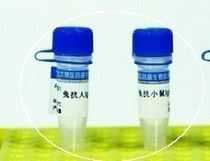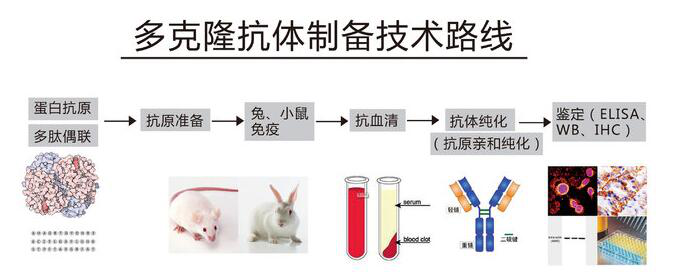
|

| 产地 | 进口、国产 |
| 品牌 | 上海莼试 |
| 保存条件 | Store at -20 °C |
| 货号 | CS10217 |
| 应用范围 | WB=1:100-500 ELISA=1:500-1000 IHC-P=1:100-500 IHC-F=1:100-500 ICC=1:100-500 IF=1:100-500 |
| CAS编号 | |
| 抗体名 | Anti-PHF/Paired Helical Filaments |
| 克隆性 | |
| 靶点 | 详见说明书 |
| 适应物种 | 详见说明书 |
| 形态 | 详见说明书 |
| 宿主 | 详见说明书 |
| 亚型 | IgG |
| 标识物 | 详见说明书 |
| 浓度 | 1mg/1ml% |
| 免疫原 | KLH conjugated synthetic peptide derived from human Paired Helical Filaments |
全、新、优、品、好四大特点:
成对螺旋细丝蛋白抗体费用 全:公司提供上万种产品,涵盖了生物试剂,elisa试剂盒,标准品,培养基,原装耗材,抗体、培养基、ATCC细胞等,基本上各种科研所需产品在我司都能找到。
新:产品更新速度较快,基本上每周都有新产品出现。
优:产品质量好,投诉比较少。
好:我公司具有优质的技术团队,产品一旦售出,实验过程中遇到困难可提供在线技术咨询。使您使用产品时没有任何的后顾之忧。
成对螺旋细丝蛋白抗体费用 英文名称 Anti-PHF/Paired Helical Filaments
中文名称 成对螺旋细丝蛋白抗体费用
别 名 Microtubule-associated protein tau; Neurofibrillary tangle protein; Paired helical filament-tau; PHF-tau; TAU_HUMAN.
产品属性:
浓 度 1mg/1ml
规 格 0.2ml/200μg
抗体来源 Rabbit
克隆类型 polyclonal
交叉反应 Human, Mouse, Rat, Cow, Horse
产品类型 一抗
研究领域 神经生物学 信号转导 Alzheimer's
蛋白分子量 predicted molecular weight: 79kDa
性 状 Lyophilized or Liquid
免 疫 原 KLH conjugated synthetic peptide derived from human Paired Helical Filaments
亚 型 IgG
纯化方法 affinity purified by Protein A
储 存 液 Preservative: 15mM Sodium Azide, Constituents: 1% BSA, 0.01M PBS, pH 7.4
成对螺旋细丝蛋白抗体费用 产品应用 WB=1:100-500 ELISA=1:500-1000 IHC-P=1:100-500 IHC-F=1:100-500 ICC=1:100-500 IF=1:100-500
(石蜡切片需做抗原修复)
not yet tested in other applications.
optimal dilutions/concentrations should be determined by the end user.
保存条件 Store at -20 °C for one year. Avoid repeated freeze/thaw cycles. The lyophilized antibody is stable at room temperature for at least one month and for greater than a year when kept at -20°C. When reconstituted in sterile pH 7.4 0.01M PBS or diluent of antibody the antibody is stable for at least two weeks at 2-4 °C.
Important Note This product as supplied is intended for research use only, not for use in human, therapeutic or diagnostic applications.
产品介绍 Neuropathology Paired structures that are core constituents of the neurofibrillary tangles of Alzheimer's disease and occur in Down syndrome, Hallervorden-Spatz disease, lead encephalopathy, lipofuscinosis, subacute sclerosing panencephalitis, and tuberous sclerosis.
Function : Promotes microtubule assembly and stability, and might be involved in the establishment and maintenance of neuronal polarity. The C-terminus binds axonal microtubules while the N-terminus binds neural plasma membrane components, suggesting that tau functions as a linker protein between both. Axonal polarity is predetermined by TAU/MAPT localization (in the neuronal cell) in the domain of the cell body defined by the centrosome. The short isoforms allow plasticity of the cytoskeleton whereas the longer isoforms may preferentially play a role in its stabilization.
Subunit : Interacts with PSMC2 through SQSTM1 (By similarity). Interacts with SQSTM1 when polyubiquitinated. Interacts with FKBP4 (By similarity). Binds to CSNK1D. Interacts with SGK1.
Subcellular Location : Cytoplasm, cytosol. Cell membrane; Peripheral membrane protein; Cytoplasmic side. Cytoplasm, cytoskeleton. Cell projection, axon. Note=Mostly found in the axons of neurons, in the cytosol and in association with plasma membrane components.
Post-translational modifications : Phosphorylation at serine and threonine residues in S-P or T-P motifs by proline-directed protein kinases (PDPK1: CDK1, CDK5, GSK3, MAPK) (only 2-3 sites per protein in interphase, seven-fold increase in mitosis, and in the form associated with paired helical filaments (PHF-tau)), and at serine residues in K-X-G-S motifs by MAP/microtubule affinity-regulating kinase (MARK1 or MARK2), causing detachment from microtubules, and their disassembly. Phosphorylation decreases with age. Phosphorylation within tau/MAP's repeat domain or in flanking regions seems to reduce tAU/MAP's interaction with, respectively, microtubules or plasma membrane components. Phosphorylation on Ser-610, Ser-622, Ser-641 and Ser-673 in several isoforms during mitosis. Phosphorylation at Ser-548 by GSK3B reduces ability to bind and stabilize microtubules. Phosphorylation at Ser-579 by BRSK1 and BRSK2 in neurons affects ability to bind microtubules and plays a role in neuron polarization. Phosphorylated at Ser-554, Ser-579, Ser-602, Ser-606 and Ser-669 by PHK. Phosphorylation at Ser-214 by SGK1 mediates microtubule depolymerization and neurite formation in hippocampal neurons. There is a reciprocal down-regulation of phosphorylation and O-GlcNAcylation. Phosphorylation on Ser-717 completely abolishes the O-GlcNAcylation on this site, while phosphorylation on Ser-713 and Ser-721 reduces glycosylation by a factor of 2 and 4 respectively. Phosphorylation on Ser-721 is reduced by about 41.5% by GlcNAcylation on Ser-717.
Polyubiquitinated. Requires functional TRAF6 and may provoke SQSTM1-dependent degradation by the proteasome (By similarity). PHF-tau can be modified by three different forms of polyubiquitination. 'Lys-48'-linked polyubiquitination is the major form, 'Lys-6'-linked and 'Lys-11'-linked polyubiquitination also occur.
O-glycosylated. O-GlcNAcylation content is around 8.2%. There is reciprocal down-regulation of phosphorylation and O-GlcNAcylation. Phosphorylation on Ser-717 completely abolishes the O-GlcNAcylation on this site, while phosphorylation on Ser-713 and Ser-721 reduces O-GlcNAcylation by a factor of 2 and 4 respectively. O-GlcNAcylation on Ser-717 decreases the phosphorylation on Ser-721 by about 41.5%.
Glycation of PHF-tau, but not normal brain TAU/MAPT. Glycation is a non-enzymatic post-translational modification that involves a covalent linkage between a sugar and an amino group of a protein molecule forming ketoamine. Subsequent oxidation, fragmentation and/or cross-linking of ketoamine leads to the production of advanced glycation endproducts (AGES). Glycation may play a role in stabilizing PHF aggregation leading to tangle formation in AD.
DISEASE : Note=In Alzheimer disease, the neuronal cytoskeleton in the brain is progressively disrupted and replaced by tangles of paired helical filaments (PHF) and straight filaments, mainly composed of hyperphosphorylated forms of TAU (PHF-TAU or AD P-TAU). O-GlcNAcylation is greatly reduced in Alzheimer disease brain cerebral cortex leading to an increase in TAU/MAPT phosphorylations.
Defects in MAPT are a cause of frontotemporal dementia (FTD) [MIM:600274]; also called frontotemporal dementia (FTD), pallido-ponto-nigral degeneration (PPND) or historically termed Pick complex. This form of frontotemporal dementia is characterized by presenile dementia with behavioral changes, deterioration of cognitive capacities and loss of memory. In some cases, parkinsonian symptoms are prominent. Neuropathological changes include frontotemporal atrophy often associated with atrophy of the basal ganglia, substantia nigra, amygdala. In most cases, protein tau deposits are found in glial cells and/or neurons.
Defects in MAPT are a cause of Pick disease of the brain (PIDB) [MIM:172700]. It is a rare form of dementia pathologically defined by severe atrophy, neuronal loss and gliosis. It is characterized by the occurrence of tau-positive inclusions, swollen neurons (Pick cells) and argentophilic neuronal inclusions known as Pick bodies that disproportionally affect the frontal and temporal cortical regions. Clinical features include aphasia, apraxia, confusion, anomia, memory loss and personality deterioration.
Note=Defects in MAPT are a cause of corticobasal degeneration (CBD). It is marked by extrapyramidal signs and apraxia and can be associated with memory loss. Neuropathologic features may overlap Alzheimer disease, progressive supranuclear palsy, and Parkinson disease. [DISEASE] Defects in MAPT are a cause of progressive supranuclear palsy type 1 (PSNP1) [MIM:601104]; also abbreviated as PSP and also known as Steele-Richardson-Olszewski syndrome. PSNP1 is characterized by akinetic-rigid syndrome, supranuclear gaze palsy, pyramidal tract dysfunction, pseudobulbar signs and cognitive capacities deterioration. Neurofibrillary tangles and gliosis but no amyloid plaques are found in diseased brains. Most cases appear to be sporadic, with a significant association with a common haplotype including the MAPT gene and the flanking regions. Familial cases show an autosomal dominant pattern of transmission with incomplete penetrance; genetic analysis of a few cases showed the occurrence of tau mutations, including a deletion of Asn-613.
Defects in MAPT are a cause of Parkinson-dementia syndrome (PARDE) [MIM:260540]. A syndrome characterized by parkinsonism tremor, rigidity, dementia, ophthalmoparesis and pyramidal signs. Neurofibrillary degeneration occurs in the hippocampus, basal ganglia and brainstem nuclei.
Similarity : Contains 4 Tau/MAP repeats.
Database links : UniProtKB/Swiss-Prot: P10636.5
PHF以神经原纤维缠结(neurofibrillary tangles, NFT)存在于神经元的胞体;以神经毯和性斑存在于受累神经元的退化树突.微管相关蛋白tau是PHF的主要组成成分.在AD脑中,特别是在PHF结构中的tau被异常过度磷酸化.用磷酸化依赖的特异抗tau抗体检测,已证明PHF中的tau蛋白至少有21个异常磷酸化位点.
实验流程:

正在热销的相关产品:
CEA/CD66(Human carcinoembryonic antign) ELISA Kit 人癌胚抗原Multi-class antibodies规格: 48T
Anti-HOXA10 HOXA10抗体Multi-class antibodies规格: 0.2ml
Rhesus antibody Rh MCM2 染色体维持缺陷蛋白2抗体 规格 0.1ml
STK(Human serine/threonine protein kinase) ELISA Kit 人丝酸/苏酸蛋酸酶 96T
RASSF6 英文名称: RAS家族关联结构域蛋白6抗体 0.2ml
C1orf156 英文名称: 1号染色体开放阅读框156抗体 0.2ml
Anti-HOXA10 HOXA10抗体Multi-class antibodies规格: 0.2ml
HMGB1 human 人高迁移率族蛋白Multi-class antibodies规格: 48T
Anti-Collagen III 抗Ⅲ型胶原抗体Multi-class antibodies规格: 0.1ml
Rhesus antibody Rh non-muscle Myosin IIA 非平滑肌肌球蛋白2A抗体 规格 0.2ml
Human amyloid beta peptide 1-40,A Beta1-40 ELISA Kit 人β淀粉样蛋白1-40 96T
phospho-Tau protein(Ser404) 英文名称: 磷酸化微管相关蛋白抗体 0.1ml
phospho-CXCR4 (Ser339) 英文名称: 磷酸化细胞表面趋化因子受体4抗体 0.2ml
Anti-Collagen III 抗Ⅲ型胶原抗体Multi-class antibodies规格: 0.1ml
Anti-IL-15/FITC 荧光素标记白介素15抗体IgGMulti-class antibodies规格: 0.2ml
Anti-PTP-1B/FITC 荧光素标记PTP-1B蛋白抗体IgGMulti-class antibodies规格: 0.2ml
Rhesus antibody Rh APG7/ATG7 自噬相关蛋白7抗体 规格 0.2ml
Rabbit Anti-rat IgG/Gold 胶体金标记的兔抗大鼠IgG 0.5ml
GMIP 英文名称: GEM相互作用蛋白抗体 0.2ml
Rhesus antibody Rh Rabbit Anti-human sIgA/Alexa Fluor 647 Alexa Fluor 647标记的兔抗人分泌型IgA 规格 0.1ml
Anti-PTP-1B/FITC 荧光素标记PTP-1B蛋白抗体IgGMulti-class antibodies规格: 0.2ml
大鼠瘤病毒16(HPV-16)ELISA试剂盒 96T/48T 试剂盒 组装/原装
人酶(CA)免疫试剂盒 Human carbonic anhydrase,CA ELISA Kit
土壤(S-Hg)浓度测试盒 可见分光光度法 50管/48样
RatTissuefactorpathwayinhibitor,TFPIELISA试剂盒大鼠组织因子途径抑制物(TFPI)ELISA试剂盒规格:96T/48T
HumanleukocyteaigenG,HLA-GELISA试剂盒人类白细胞抗原G(HLA-G)ELISA试剂盒规格:96T/48T
humannuclearfactorofkappalightpolypeptidegeneenhancerinB-cellsinhibitorepsilon,Nfkbie人B细胞κ轻肽基因增强子核因子抑制因子ε(Nfkbie)ELISA试剂盒规格:96T/48T
大鼠补体蛋白3(C3)ELISA 试剂盒 96T/48T 试剂盒 组装/原装
人糜蛋白酶免疫试剂盒 Human chymoypsin ELISA Kit
MouseVisceraladipose-specificserineproteaseinhibitor,vaspinELISAKit小鼠内脏脂肪特异性丝氨酸蛋白酶抑制剂(vaspin)ELISA试剂盒规格:96T/48T
石蜡切片组织CASPASE-8蛋白表达NBT显色光学显微镜检测试剂盒10/20次
HumanProteinCELISA试剂盒人蛋白C(ProteinC)ELISA试剂盒规格:96T/48T
HumahyroidAibody,TAbELISAKit人甲状腺抗体(TAb)ELISA试剂盒规格:96T/48T
成对螺旋细丝蛋白抗体费用 大鼠蛋白酶激活受体2(PAR2)ELISA试剂盒 ,英文名: PAR2 ELISA Kit
Human ICE protease activating factor (IRAP) ELISA Kit 人ICE蛋白酶激活因子(IRAP)ELISA试剂盒
RatLeptin,LEPELISAkit 大鼠瘦素(LEP)ELISA试剂盒 96T/48T 进口分装
CLIAKitforCYFRA21-1(Humancytokeratinfragmeaigen21-1)ELISAKit人细胞角蛋白21-1片段规格:48T/96T
细胞色素P450亚酶CYP2B6(EFC)活性荧光定量检测试剂盒20次
RatFMS-liketyrosinekinase3,Flt3ELISAKit大鼠FMS样酪氨酸激酶3(Flt3)ELISA试剂盒规格:96T/48T
技术外包服务:
★成对螺旋细丝蛋白抗体费用 分子生物学:质粒抽提、PCR、Q-PCR、RT-PCR、分子生物学:基因合成、引物合成、基因测序、载体构建等
★蛋白工程:原核、哺乳动物蛋白表达系统等
★病毒包装:腺病毒、慢病毒等
★抗体工程:磁珠分选、病理染色、WB、ELISA、IP、IF、IHC、FACS、Confocal等等
★细胞工程:细胞表型分析(凋亡、增殖、周期、迁移、侵袭、修复、克隆形成)、细胞培养、细胞膜制备、稳定细胞株构建、细胞RNAi技术等等。